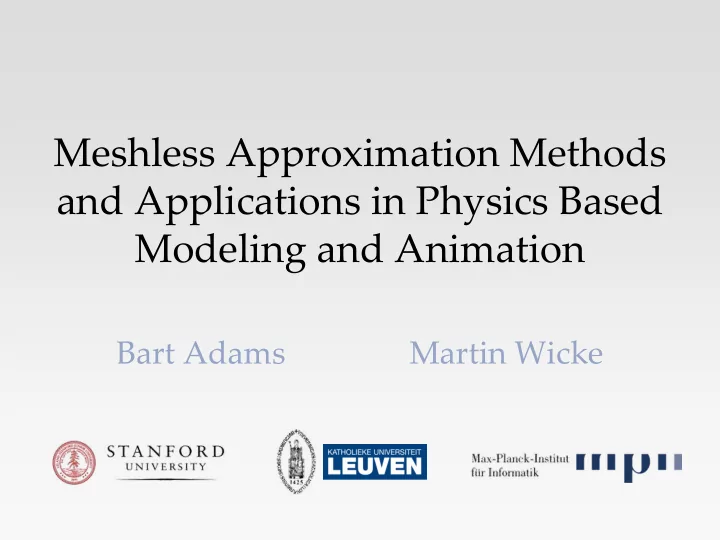

Tutorial Overview Meshless Methods smoothed particle hydrodynamics moving least squares Applications particle fluid simulation elastic solid simulation shape & motion modeling Conclusions
Fluid Simulation
Eulerian vs. Lagrangian Eulerian Simulation Discretization of space Simulation mesh required Better guarantees / operator consistency Conservation of mass problematic Arbitrary boundary conditions hard
Eulerian vs. Lagrangian Lagrangian Simulation Discretization of the material Meshless simulation No guarantees on consistency Mass preserved automatically (particles) Arbitrary boundary conditions easy (per particle)
Navier ‐ Stokes Equations Momentum equation: Continuity equation:
Continuity Equation Continuum equation automatically fulfilled Particles carry mass No particles added/deleted No mass loss/gain Compressible Flow Often, incompressible flow is a better approximation Divergence ‐ free flow (later)
Momentum Equation Left ‐ hand side is material derivative “How does the velocity of this piece of fluid change?” Useful in Lagrangian setting
Momentum Equation Instance of Newton’s Law Right ‐ hand side consists of Pressure forces Viscosity forces External forces
Density Estimate SPH has concept of density built in X ρ i = w ij m j j Particles carry mass Density computed from particle density
Pressure Pressure acts to equalize density differences à ! γ ρ p = K ( − 1) ρ 0 CFD: γ = 7, computer graphics: γ = 1 large K and γ require small time steps
Pressure Forces a p = −∇ p Discretize ρ Use symmetric SPH gradient approximation Preserves linear and angular momentum
Pressure Forces Symmetric pairwise forces: all forces cancel out Preserves linear momentum x i − x j Pairwise forces act along Preserves angular momentum
Viscosity Discretize using SPH Laplace approximation Momentum ‐ preserving Very unstable
XSPH (artificial viscosity) Viscosity an artifact, not simulation goal Viscosity needed for stability Smoothes velocity field Artificial viscosity: stable smoothing
Integration Update velocities Artificial viscosity Update positions
Boundary Conditions Apply to individual particles Reflect off boundaries 2 ‐ way coupling Apply inverse impulse to object
Surface Effects Density estimate breaks down at boundaries Leads to higher particle density
Surface Extraction Extract iso ‐ surface of density field Marching cubes
Demo (sph)
Extensions Adaptive Sampling [Adams et al 08] Incompressible flow [Zhu et al 05] Multiphase flow [Mueller et al 05] Interaction with deformables [Mueller et al 04] Interaction with porous materials [Lenaerts et al 08]
Tutorial Overview Meshless Methods smoothed particle hydrodynamics moving least squares data structures Applications particle fluid simulation elastic solid simulation shape & motion modeling Conclusions
Application 2: Elastic Solid Simulation
Goal Simulate elastically deformable objects
Goal Simulate elastically deformable objects efficient and stable algorithms ~ different materials elastic, plastic, fracturing ~ highly detailed surfaces
Elasticity Model What are the strains and stresses for a deformed elastic material?
Elasticity Model Displacement field
Elasticity Model Gradient of displacement field
Elasticity Model Green ‐ Saint ‐ Venant non ‐ linear strain tensor symmetric 3x3 matrix
Elasticity Model Stress from Hooke’s law symmetric 3x3 matrix
Elasticity Model For isotropic materials Young’s modulus E Poisson’s ratio v
Elasticity Model Strain energy density Elastic force
Elasticity Model Volume conservation force prevents undesirable shape inversions
Elasticity Model Final PDE
Particle Discretization
Simulation Loop
Surface Animation Two alternatives Using MLS approximation of displacement field Using local first ‐ order approximation of displacement field
Recommend
More recommend